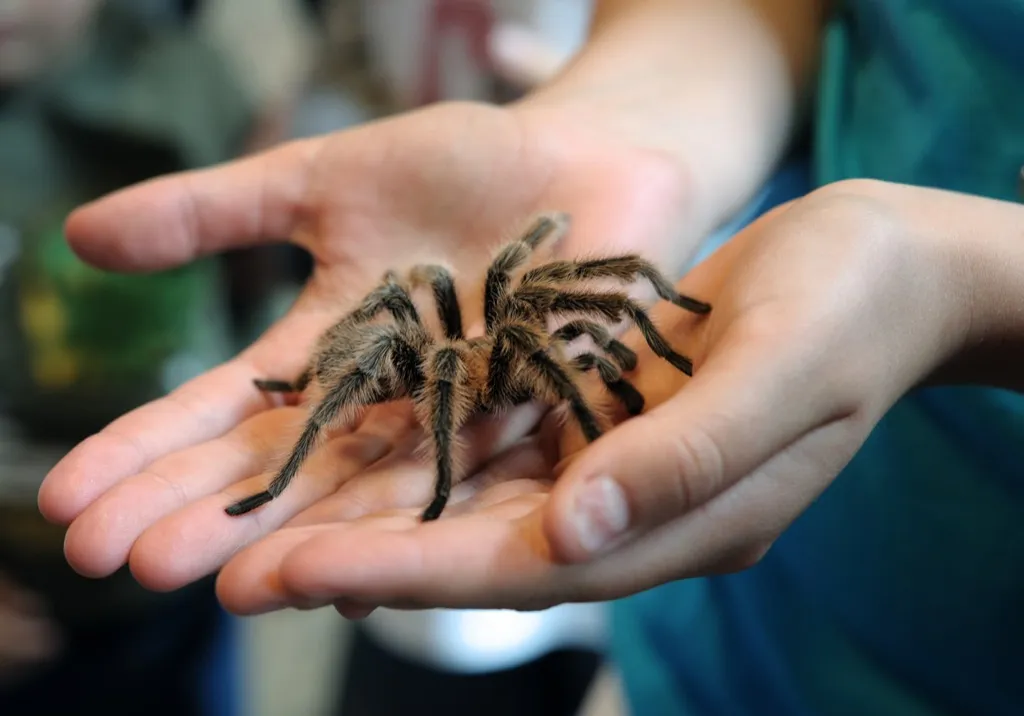The 50 Most Dangerous Bugs in America

When you think of deathly, dangerous bugs, it’s a good bet you think of some myth-like monster in some far-flung locale. You know, the Tse Tse fly in Tanzania, or the wandering spider in Brazil. It might feel like the United States is an insect-free oasis—at least compared to Australia, where spiders literally fall like raindrops, by the thousands, in a terrifying phenomenon aptly dubbed, “spider rain.” But the unfortunate reality is that dangerous insects are likely lurking in your own backyard.
Yes, America is home to several species of spiders, scorpions, and even caterpillars that pose a serious threat to your health—in some cases causing paralysis or even death. To help you identify any potential dangers, we’ve compiled a compendium of the most dangerous bugs in the United States.
1
Black Widow Spiders

The black widow might not be much bigger than the average paper clip, but it’s certainly more dangerous. According to National Geographic, its venom is 15 times more potent than that of a rattlesnake—though, contrary to common myths, few people ever perish at the hands of the small spider. Rather, a black widow bite can cause muscle aches, nausea, and difficulty breathing.
2
Red Widow Spiders

The good news is that the red widow spider is only found in certain parts of Florida. The bad news is that should you get bitten by one, the venom is a neurotoxin and can potentially cause permanent muscle spasms.
3
Africanized Honey Bees

The Africanized honey bee, or killer bee, was first introduced to America after an experiment gone wrong, according to the Smithsonian. In the 1950s, colonies of African honey bees were brought into Brazil for cross-breeding in order to increase honey output. Unfortunately, some of the African queens and worker bees made an escape and bred instead with European honey bees, creating the killer bee hybrid. By 1990, these killer bugs found their way into southern Texas, and in 2014 scientists documented them in San Francisco.
What makes these bees “killer” is the fact that they are ten times faster than European honey bees and are much more aggressive. “Africanized bees respond to colony disturbance more quickly, in greater numbers, and with more stinging,” according to research from 1982. In the past 50 years, the brutal bugs have been responsible for hundreds of deaths, so make sure to keep your distance.
4
Arizona Bark Scorpions

Commonly found in the Sonoran Desert in Arizona and California, the Arizona bark scorpion is one of the most dangerous scorpions known to the United States. A person stung by this thin-tailed creature can experience painful swelling, breathing difficulties, and muscle spasms, and should seek medical attention as soon as possible.
5
Brown Recluse Spiders

Residents of the south-central and midwestern United States, watch out. Lurking in your woods (and possibly even in your closets) are small, brown spiders with venom that can potentially make you sick and scar your skin, according to the University of Kentucky’s College of Agriculture, Food, and Environment. These arachnids, known as brown recluse spiders, aren’t vicious in nature, but come into contact with one by accident (say, for instance, if you roll over one in your sleep) and risk getting bitten.
6
Red Harvester Ants

Ants are completely harmless, right? Wrong. Found in the western United States (primarily in Texas), Red harvester ants—or worker ants—are foragers with a brutal bite. Though they don’t attack unless provoked, a red harvester’s sting is “bold and unrelenting, like somebody using a drill to excavate your ingrown toenail,” as Insect Defenses co-author Justin Schmidt explained to Travel & Leisure.
7
Fire Ants

Red harvesters aren’t the only ants you have to be on the lookout for. Any resident of a southern state will be able to tell you that fire ants are just as ruthless, with a hive mentality that causes them to gang up on intruders and in severe cases, even kill them. One species of fire ants, known as red imported fire ants, has become such a problem that it’s now considered an “invasive” species in the United States.
8
Striped Bark Scorpions

Striped bark scorpions can be found in states like Texas, New Mexico, Arkansas, Colorado, and Louisiana. Their stings pack a punch that can last a few days, but no deaths have ever been attributed to them.
9
Paper Wasps

While not as hostile as yellowjackets, paper wasps will sting you should you encroach on their territory—and it will hurt. Their stings occasionally cause allergic reactions, but otherwise they are all bark and no bite (as in, you really have nothing to worry about from a health perspective.)
10
Sac Spiders

Residents of New England and the Midwest should watch out for the yellow sac spider. According to a report from Michigan State University, the small arachnid is responsible for more bites than any other species of spider, and they will attack “without provocation.” A sac spider bite is painful for the first 10 hours or so and might cause bruising and blistering, but it almost never results in anything serious or life-threatening.
11
Io Moth Caterpillars

In the summertime, those who reside in the South are warned to watch out for io moth caterpillars. One man in Louisiana who was stung by one told KPLC that the bite was “excruciating.” “It wasn’t just like a bee sting,” he explained.
12
Tarantulas

People sometimes keep tarantulas as pets (and for what reason, we aren’t entirely sure), but these furry spiders can actually be pretty dangerous. Tarantulas don’t attack often, but when they do, their bites can cause redness, swelling, and even muscle spasms, as was the case for one man in Switzerland who was bitten by his pet tarantula during feeding time.
13
Oriental Rat Fleas

Remember the plague that wiped out a majority of the world’s population in the Middle Ages? Well, you can thank oriental rat fleas for that one. Rats might have been the vessels spreading the plague, but it was oriental rat fleas who actually carried the disease. And though the plague is rare today, it still exists in parts of California, Arizona, Colorado, and New Mexico, thanks to these fleas.
14
Wheel Bugs

The wheel bug is a member of the assassin bug family, so named because of their tendency to capture prey with a quick stab of their mouthparts. Wheel bugs will generally only attack large insects, but if picked up and prodded by a human, they aren’t afraid to bite. And though their bites aren’t fatal, Texas A&M’s Agrilife Extension describes them as “immediately and intensely painful.”
15
Cockroaches

If you live in a big city, then chances are that you’ve encountered a cockroach crawling in the crevices of your apartment. But while most of us only consider cockroaches as a threat to our groceries, it turns out that these giant bugs also bite. Cockroaches will eat anything—including human flesh—and so they might nip you if they get hungry. Areas of interest include feet, hands, fingernails, and eyelashes.
16
Tarantula Hawks

The tarantula hawk is one of the most venomous insects in the world. But lucky for us, this spider wasp’s target is not human, but arachnid. As its name suggests, these insects have a habit of hunting large tarantulas—and they are able to do so thanks to their paralyzing venom. For a human, a tarantula hawk bite will feel “instantaneous, electrifying, and totally debilitating,” according to Schmidt, but it isn’t strong enough to paralyze you.
17
German Yellowjackets

People really need to keep their dangerous insects on a tighter leash. In 1975, the German yellowjacket was accidentally introduced into the United States in Ohio, and the buzzing bullies have been a problem ever since. Yellowjackets will build their nests wherever they can find space—like in attics and under roofs—and should you disturb them, they aren’t afraid to sting you…repeatedly. To prevent a painful situation, avoid leaving out food (they love anything sweet) and always keep your doorways and windows protected by a screen.
18
Botflies

Regular houseflies are nothing to be afraid of. Botflies, on the other hand, are a menace. They lay their eggs on mosquitos, and those eggs subsequently end up on humans. When they hatch, the larvae burrow into the host’s skin and become parasitic.
19
Puss Caterpillars

Do not pet this fuzzy wuzzy. Despite its cuddly appearance, the puss caterpillar is actually the most dangerous caterpillar in the United States, according to National Geographic. Its fuzzy “hairs” are toxic spines that can stick your skin and spur a painful reaction.
“A puss caterpillar sting feels like a bee sting, only worse,” entomologist Don Hall told National Geographic. “The pain immediately and rapidly gets worse after being stung, and can even make your bones hurt.”
20
Kissing Bugs

Previously only found in Mexico and South America, kissing bugs are now a growing problem in the southern United States. According to research from Texas A&M University, over 50 percent of kissing bugs in Texas carry the parasite that is responsible for Chagas disease, which can lead to everything from body aches to heart failure.
21
Browntail Moth Caterpillars

Found on the coast of Maine and Cape Cod, the browntail moth caterpillar has poisonous hairs that, if touched, cause a reaction similar to poison ivy. And you don’t even necessarily have to touch the caterpillar for the reaction to occur; the toxic hairs can separate from the caterpillar and land on a person’s skin while traveling through the air, causing the dermatitis.
22
Asian Giant Hornets

Meet the Asian giant hornet, the largest and deadliest hornet in the world. Reportedly found in Virginia and Illinois, this monster holds such a powerful venom that it can destroy red blood cells and cause a human’s kidneys to shut down. In 2013, Chinese citizens suffered 42 deaths and 1,675 injuries at the hands of these giant bugs, according to CNN.
23
Ticks

Everyone who lives in an area teeming with deer knows about Lyme disease, but that’s not the only infection that ticks carry. According to a report released by the Centers for Disease Control and Prevention (CDC), the amount of tick-borne illnesses has more than doubled in the past 13 years. Such diseases to be aware of include anaplasmosis (a bacterial infection), Rocky Mountain spotted fever, and babesiosis (a red blood cell disease).
24
Mosquitoes

We all know them, and we all hate them. Beyond making us itchy to no avail, mosquitoes can transmit such diseases as malaria, dengue, yellow fever, and St. Louis Encephalitis. And according to the American Mosquito Control Association, more than one million people worldwide die annually from illnesses passed on to them via mosquito.
25
Centipedes

Centipedes won’t bite you, but they might pinch you if you get on their nerves. And while venomous centipedes won’t cause any major harm, their pinches can potentially cause a reaction not unlike a bee sting (think swelling, redness, and pain).
26
Hobo Spiders

The hobo spider became ubiquitous throughout the United States with the help of railways (thus giving the spider its name). Though they won’t attack unless they are defending themselves, their bites can cause long-lasting headaches, bone and joint pain, muscle weakness, and hallucinations. Though hobo spiders are venomous, scientists have found that the creatures tend to only use their venom on prey.
27
Chiggers

Chiggers are the larvae of trombiculid mites. Invisible to the human eye unless in groups, these mites feed on human skin cells and their saliva leaves behind itchy, irritated bumps.
28
Asian Lady Beetles

The Asian lady beetle was introduced into the United States in 1988 in order to slash aphid populations. Unfortunately, these beetles are a threat to vegetation and have a tendency to bite, and so they are now considered a pest, just like the one they were brought in to eliminate. Their bites aren’t life-threatening, but in some instances, they trigger an allergic reaction that causes pink eye.
29
Giant Resin Bees

Whoever is out there making giant bees and wasps, please stop—or at the least, stop bringing them to the United States. This extra large insect was first spotted in the United States in 1994, and today they can be found everywhere from Virginia to Alabama. Like most of their relatives, these bees won’t sting unless provoked… so don’t provoke them.
30
Bald-Faced Hornets

Commonly found in the southeastern United States, this aerial yellowjacket is a vigorous defender of its territory. Should its nest be disturbed, it will sting the intruder repeatedly—and it can even squirt venom into an intruder’s eyes to temporary blind them.
31
Horseflies

The good news about the horsefly is that it isn’t going to bite you while you sleep. The bad news is that it will bite you while you sit out and sunbathe, and the wound it causes can potentially become infected and scar. “[Horsefly] bites take a massive chunk out of your skin, so they hurt more, and they generally tend to scare more,” Dr. Ranj Singh told Express. Ouch.
32
Sandflies

Sandflies are members of the fly family with mouthparts similar to that of the mosquito. And like their relatives, the female sandfly uses said mouthpart to feed on human blood. Unfortunately, sandflies can deposit diseases into the bloodstream when they feed, and in the past these creatures have been known to spread such illnesses as typhus and the plague, according to a study published in the Infection, Genetics and Evolution journal.
33
Bed Bugs

Every person’s worst nightmare is a bed bug infestation. Not only are these pests nearly impossible to get rid of once they’ve taken up residence in your home, but they also love to feed on human blood and leave painful, itchy bites in their wake. If you ever think that you might be experiencing a bed bug infestation, call the exterminator as soon as possible—after all, an estimated one in five Americans have either dealt with these creatures or know someone who has.
34
Termites

Technically, termites aren’t dangerous to humans, as they aren’t known to bite humans (save for soldier termites). However, these pests can infest homes and cause thousands of dollars in damage, making them a danger to your wallet and earning them a spot on the list.
35
Velvet Ants

Don’t let their names deceive you. These cow killer ants, as they’re called, are actually wasps with a sting as strong as their relatives (though only the females have stingers). Popular Science described the suffering from a velvet ant’s sting as “30 minutes of life-changing, pray-for-death pain.”
36
Wolf Spiders

Unlike other intimidating species of spiders, wolf spiders can be found nearly everywhere in the world, regardless of habitat. The good news? While they may be perceived as incredibly deadly by their prey, they aren’t as likely to do as much damage to humans.
However, if a wolf spider feels as though it is continuously being provoked, it will inject venom into its pursuer. Upon being bitten, you are likely to experience symptoms like swelling, mild pain, and itching at the site of the attack.
37
Saddleback Caterpillars

Found mostly in the Eastern United States, saddleback caterpillars are just as strange-looking as they are dangerous. According to the University of Florida’s Entomology and Nematology departments, these creatures tend to embed their long spines (displayed in the photograph above) into their victims whenever they feel threatened. Unfortunately for anyone or anything on the receiving end of this prickly attack, these spines contain hemolytic and blister-forming venom that causes direct tissue damage in its victims. As far as humans are concerned, though, this sting only results in mild to moderate pain—though some who have been stung claim that the sting is more painful than that of a bee or wasp.
38
Southern Black Widow Spiders

The southern black widow spider—as its name suggests—is mainly found in the Southern portion of the country, most commonly in the state of Florida. And in a similar fashion to the black widow spiders in other regions of the country, the bite of a southern black widow can be incredibly painful and harmful to both humans and small animals.
According to Penn State’s College of Agricultural Sciences, while the pain of a southern black widow bite isn’t noticeable until a few hours out from the attack, it proves to be nearly intolerable once it kicks in. The symptoms of a southern widow spider bite include nausea, chills, slight fever, a rise in blood pressure, a burning sensation of the skin, fatigue, and motor disturbances—though after four days, these symptoms generally dissipate.
39
Buck Moth Caterpillars

The fearsome creature known as the buck moth caterpillar can be found anywhere in the Eastern United States—but if you do happen to come across one, you’ll want to try your best not to provoke it. After causing immediate pain, the sting from this caterpillar’s multi-branched urticating spines spreads to the lymphatic nodes where it has the power to do incredible damage to the body. In cases where the victims receive multiple stings from the buck moth caterpillar, hemorrhaging around the site of the sting—and even death, in rare cases—can occur.
40
Maricopa Harvester Ants

Typically found in the Southwestern region of the United States, the Maricopa harvester ant holds one of the most toxic venoms known to man, according to Navajo Nature. However, though the venom produced by this species of ant can kill smaller vertebrates, it typically only produces a slight pain in humans. To kill a human, the Maricopa harvester ant would need to sting at least 350 times.
41
Emerald Ash Borers

For those who rely on ash trees to pay the bills—or even for those environmentalists trying to preserve the country’s untouched land—the emerald ash borer is Public Enemy No. 1. Though the insect may not immediately affect the health of humans, it does pose long-term economic problems for the entire country.
According to the New York State Department of Environmental Conservation, the estimated annual contribution of forest-based manufacturing, recreation, and tourism to the New York state economy is over $9 billion. However, with the presence of this invasive species slowly devouring the large populations of ash trees in the state, New York alone could lose millions, if not billions, of dollars in the coming years if these insects aren’t eradicated.
42
Mountain Pine Beetles

Since 1996, the mountain pine beetle has managed to destroy millions of acres of ponderosa and lodgepole pine trees in Colorado. At the beginning of 2013, an annual assessment by the state’s forest service found the bothersome beetles in some 264,000 acres of trees in Colorado. So, though the mountain pine beetle doesn’t present an imminent threat to the health of humans, it does present both an economical and environmental danger to all forms of life in the United States.
43
Hag Moths

Though the hag moth looks essentially harmless, experts at the University of Kentucky’s Entomology Department beg to differ. As it turns out, these moths actually possess nine pairs of fleshy lobes equipped with savage stinging hairs. Reactions from a hag moth sting can range from mild itching to more severe pain, swelling, blistering, dermatitis, and even intestinal problems.
44
Lice

Though they don’t necessarily pose life-threatening harm to their human victims, lice do prove to be an incredibly annoying disturbance. According to the Mayo Clinic, those affected with head lice can expect symptoms ranging from intense itching to small red bumps on the scalp, neck, and shoulders.
45
Locusts

Thanks to all the havoc they’re wreaked on crops intended to feed large populations of people, locusts have been blamed for thousands of deaths over the years. Since the rule of the Ancient Egyptians, the presence of locusts has been feared—so much so, in fact, that the insects were used as a threat in the Iliad, the Bible, and the Quran.
46
Citrus Long-Horned Beetles

While the citrus long-horned beetle can’t physically hurt humans, it does pose a serious threat to habitats all across the United States. Since it was discovered in 1999 in Athens, Georgia, the insect has devoured thousands of hardwood trees across the United States—and according to the University of Florida’s Entomology and Hematology departments, it could cost millions (if not billions) of dollars to eradicate.
47
Spiny Oak-Slug Caterpillars

Similar to the other caterpillars on this list, spiny oak-slug caterpillars are equipped with a series of stinging spines that, when injected into a human’s skin, can cause pain, itching, burning, irritation, and redness. And though this creepy caterpillar’s sting is not considered lethal, those who are allergic to other insect stings should be wary of coming in contact with this creature, as they are at risk of experiencing an allergic reaction.
48
Wheat Weevils

Though the effect of the wheat weevil on stored grains around the world has never been properly documented, the insect is known to do significant damage to harvested stored grains in all corners of the world, the United States included. These evil weevils eat wheat, oats, rye, barley, rice, and corn, and they significantly impact the yield of these crops for nearly every farmer, according to the United States Department of Agriculture.
49
Asian Citrus Psyllids

In the states that often see warmer temperatures all year long, Asian citrus psyllids pose a serious threat to citrus plants and their relatives. According to the United States Department of Agriculture, these insects are actually the carriers of a bacterium that causes Huanglongbing disease, or citrus greening disease, which has been proven to be one of the most harmful citrus plant diseases in the world.
For those who rely on citrus plants to earn a living, asian citrus psyllids—and the disease they carry—have proven to be devastating. In fact, according to the Atlantic, the production of oranges in Florida declined significantly in 2015—a 63 percent decrease in production, to be exact. So, it should go without saying that these little bugs have cost the agriculture business quite a bit of money since they were first discovered.
50
Varroa Mites

The biggest threat to your local honey? Believe it or not, it’s the Varroa mite. These insects are external parasites, meaning that they nest in beehives and slowly drain bees of their blood until there is nobody left to keep the hive running. Naturally, varroa mites have proven to be incredibly harmful to both bees and honey production all across the world. And for dangerous creatures living under water, here are 20 Sea Creatures More Dangerous Than Sharks.
To discover more amazing secrets about living your best life, click here to follow us on Instagram!